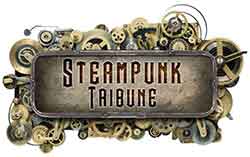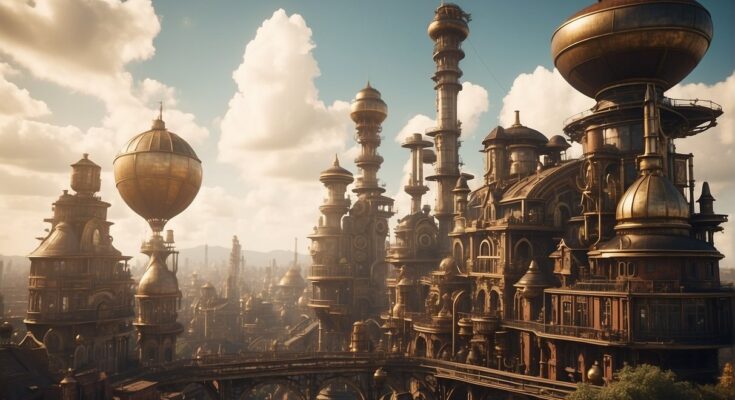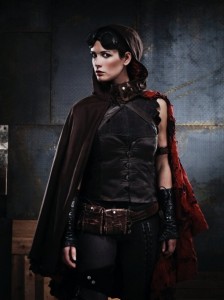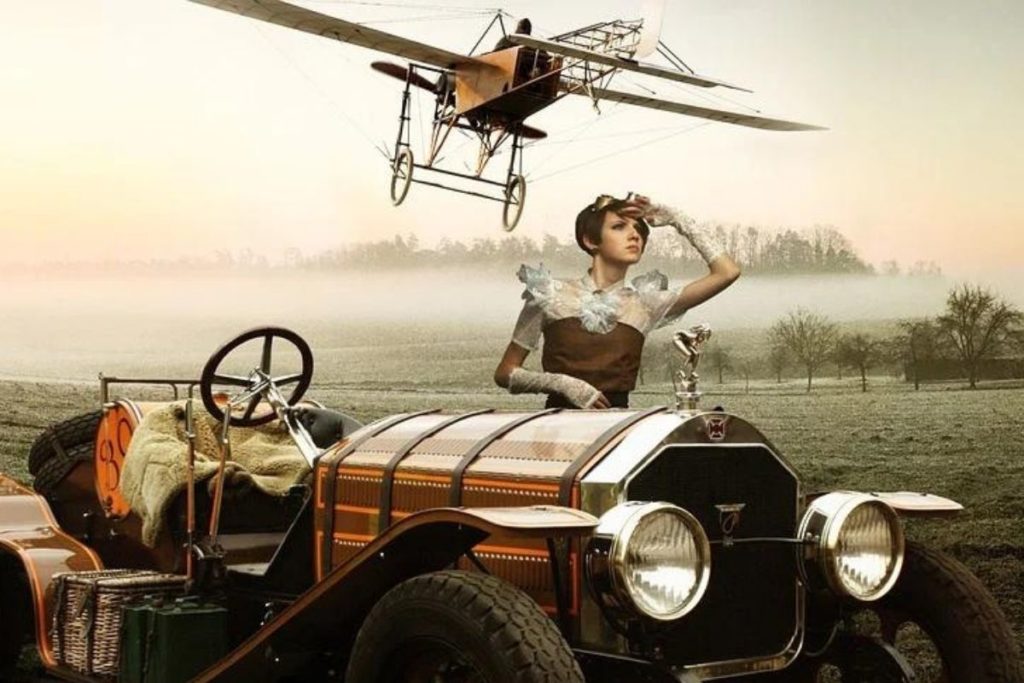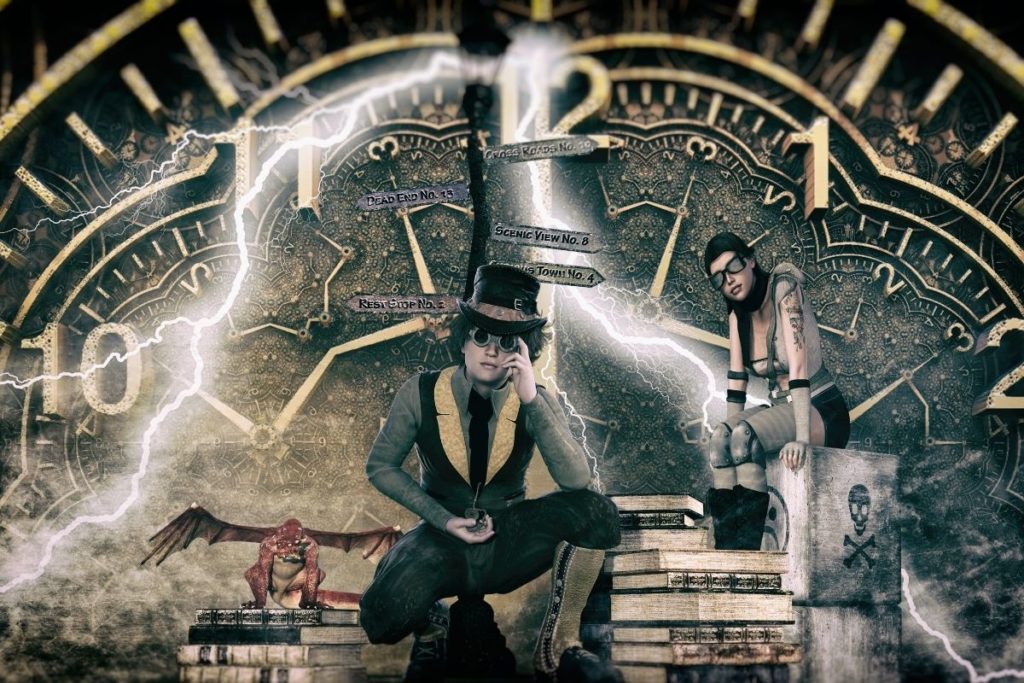Steampunk anime films offer a unique blend of science fiction and 19th-century industrial steam-powered machinery aesthetics. This genre is characterized by its alternative history settings, where steam technology remains predominant, often stretching into the realms of the fantastic. It merges the artistic style and sensibilities of anime with the intricate, mechanical world of steampunk, creating stories filled with airships, gears, and retro-futuristic inventions.

These narratives frequently explore themes of adventure, exploration, and the consequences of technology on society and individuals. Steampunk anime films are visually distinct, showcasing a fascination with mechanical innovation and Victorian-era design, which is translated on-screen through detailed animation and creative storytelling. The imagery in these films is meticulously crafted to reflect a world where steam power has shaped technology, architecture, and culture.
Steampunk anime is a testament to the limitless imagination of its creators, offering audiences a vision of what the past might have looked like had the future come early. The films often feature intrepid characters, elaborate plots, and a strong sense of adventure that keeps viewers engaged. As a notable niche within the broader anime genre, steampunk anime continues to captivate fans with its unique aesthetic and thought-provoking storylines.
Historical and Cultural Context

Steampunk anime films reflect a rich historical tapestry, drawing from 19th-century aesthetics and literary influences. They creatively merge the industrialized Victorian era with speculative futuristic visions, often underpinned by the works of iconic writers like Jules Verne.
19th Century Origins
The steampunk genre derives its visual and cultural essence from 19th-century culture. Thought of as a retrofuturistic interpretation, it converges the time’s Victorian ethos with steam-powered machinery characteristic of the Industrial Revolution. The Victorian era serves as a backdrop to many steampunk narratives, providing a stark contrast between historical authenticity and imaginative technology.
The culture within these films often critiques or romanticizes elements from the past, such as societal structures and technological advancements. Steampunk anime balances the two, dissecting the struggles of industrialized societies amid a backdrop of steam engines, gear-driven devices, and mechanization.
Influence of Jules Verne
Jules Verne’s works had a profound effect on the shaping of steampunk as a genre. His novels, like Twenty Thousand Leagues Under the Sea and Journey to the Center of the Earth, exhibit an inventive blend of science fiction and adventure, deeply embedded within 19th-century sensibilities.
- Adventurous Spirit: Characterizing an era of exploration, Verne’s stories are replete with protagonists displaying ingenuity and courage.
- Technological Marvels: His vivid depictions of submarines and aircraft ahead of their time have directly inspired the design of machines and gadgets in steampunk anime.
- Cultural Impact: Verne’s literature resonates within steampunk anime through its exploration of human experience and societal impact of technological advances.
These films not only pay homage to Verne’s imaginative machines but also to his speculative spirit, which champions a blend of scientific discovery and fictive speculation.
Key Steampunk Anime Films

Steampunk anime films merge the aesthetics of steam-powered machinery with imaginative storytelling, often set in an alternate history or a fantasy world. These films blend technology and period elements to create unique narratives that have significantly shaped the genre.
Landmark Titles
- Steamboy (2004): Directed by Katsuhiro Otomo, this film is a visually stunning representation of steampunk, showcasing an alternate 19th-century England and the invention of a steam-powered device capable of immense power.
- Castle in the Sky (1986): Directed by Hayao Miyazaki, this classic from Studio Ghibli is one of the pioneering titles in the genre, featuring flying cities, airships, and a search for a mystical floating island.
- Last Exile (2003): This series features an intricate world with airship battles and a complex plot, presenting detailed steam-powered technology in a realm where flight is the primary mode of transport.
- Kabaneri of the Iron Fortress (2016): This series offers a fusion of steampunk and horror, focusing on a survival story amidst a zombie outbreak in a steampunk vision of the industrial revolution.
- Fullmetal Alchemist: Brotherhood (2009-2010): Albeit more magic-centered, this anime incorporates key steampunk elements through alchemy and a pseudo-European setting reminiscent of early industrial societies.
Influence on Genre
- Influence of Steamboy: Steamboy’s intricate animation and storytelling set a high standard for steampunk visuals and mechanical design in anime, encouraging the development of series like Fullmetal Alchemist: Brotherhood.
- Fullmetal Alchemist: Brotherhood’s Broader Appeal: With a blend of alchemy and industrial-era technology, this anime extended the popularity of the genre beyond hardcore fans, influencing the stylistic choices of series like Princess Principal.
- Princess Principal (2017): Combining a steampunk aesthetic with a spy narrative, this anime illustrates the versatility of the genre and its ability to adapt and meld with other storytelling motifs.
The films and series listed not only reflect the richness of the steampunk genre in anime but also demonstrate its transformative impact on storytelling, art design, and the expansion of what the genre can encompass. These titles are essential viewing for anyone interested in the fusion of history, technology, and narrative complexity that is signature to steampunk anime.
Themes and Motifs

Steampunk anime films often intertwine distinctive themes and motifs that bring to life an alternative historical reality where steam power is paramount. They explore the narrative depth through a lens of nostalgia and futuristic aspirations.
Adventure and Exploration
Steampunk anime place a strong emphasis on adventure and exploration. Characters often find themselves on grand quests, whether they are sky pirates navigating uncharted air currents or samurai on a mission in a mechanized version of feudal Japan.
- Samurai: Embodying the spirit of adventure, samurai in steampunk settings often face challenges where traditional codes meet futuristic technologies.
- Pirates: Characters like pirates search for treasures and undiscovered lands, adding a sense of thrill and wanderlust to the narrative.
These films tap into the allure of the unknown, creating worlds that invite viewers to discover the unexplored terrains alongside the characters.
Technology and Innovation
The theme of technology and innovation is central to steampunk, focusing on anachronistic machinery and the impact of invention on society. Steampunk anime films examine how characters utilize and interact with advanced technology despite the Victorian-era setting.
- Alchemy: Characters use alchemy as a narrative device to demonstrate mankind’s desire to control and reform nature through science and innovation.
- Invention: Inventions, often powered by steam, highlight the creative and sometimes reckless pursuit of progress, with iconic imagery of gears, cogwheels, and airships.
- Science Fiction: The science fiction aspect contributes significantly to the setting, with spies using retro-futuristic gadgets and explorers coming across incredible steam-powered contrivances.
Steampunk anime weaves these themes into its narrative fabric, showcasing human ingenuity’s triumphs and perils in a world that marries the past with a speculative future.
Artistic and Technical Aspects

Steampunk anime films excel in creating intricate worlds and characters. They blend 19th-century industrial steam-powered aesthetics with futuristic concepts, making for a visually stunning and technologically fascinating viewing experience.
World-Building in Animation
Steampunk anime often feature steam-powered machinery and complex airship designs as cornerstones of their worlds. The film “Castle in the Sky” by Studio Ghibli, co-founded by Hayao Miyazaki, is a prime example of masterful world-building. It showcases elaborate flying machines and a meticulously crafted world suspended in the air, combining the rustic charm of steam technology with the boundless possibilities of airship travel. The fusion of traditional and mechanical elements creates a believable yet fantasy-rich setting that is a hallmark of Miyazaki’s work.
- Notable World-Building Elements:
- Steam-powered machinery
- Airships and floating cities
- Retro-futuristic cities
Another exemplary film, Metropolis, portrays a towering city where humans and robots coexist. The anime takes inspiration from Fritz Lang’s classic while injecting a steam-driven energy into its towering skyscrapers and labyrinthine underbelly.
Character Design and Aesthetics
In Steampunk anime, character design is often a reflection of the world’s aesthetic, with clothing and gadgets that exude both functionality and style. Characters are frequently adorned with Victorian-inspired attire, complete with brass goggles, leather boots, and mechanical accessories that highlight their roles within the story.
- Key Character Design Elements:
- Victorian fashion elements
- Mechanical devices and robots
- Signature accessories (goggles, gears)
Akira, while not traditionally steampunk, incorporates the technical prowess and detailed aesthetics typical of the genre. It’s evident in the characters’ cybernetic enhancements and the intricate motorcycle designs that have become iconic in the anime industry. These designs captivate the audience and clearly convey the characters’ personalities and histories.
Impact and Legacy
Steampunk anime films have carved a unique niche within the animation industry, leaving an indelible mark on both future creations and the communities that celebrate them.
Influence on Future Creations
Steampunk anime has inspired a multitude of creative endeavors across various media. Notably, Studio Ghibli’s “Howl’s Moving Castle” and “Laputa: Castle in the Sky” offer distinctive steampunk aesthetics that have shaped the visual standards of the genre. Their influence is evident in the meticulous attention to mechanical details and the imaginative intersection with elements of alternate history. These films have prompted filmmakers to explore complex narratives where technology and the past converge, often incorporating themes like espionage and the human relationship with insects, reflecting deeper ecological and societal issues.
Netflix and Funimation, major streaming platforms, have capitalized on the popularity of steampunk anime by hosting a variety of titles from this genre. Their catalogs feature stories that showcase elaborate steam-powered machinery and Victorian-era settings, further cementing steampunk’s impact on contemporary anime storylines. The proliferation of steampunk anime on such platforms ensures its continued influence on the thematic and visual elements of future anime productions.
Community and Fandom
The steampunk genre has fostered a passionate fanbase, with anime adding a vibrant layer to the global steampunk community. Conventions are hotspots for fans to gather, often featuring steampunk-themed anime panels and cosplays. Exhibiting both the Victorian flair and mechanical innovation typical of steampunk, these gatherings forge strong community ties.
- Clubs and Online Forums: Enthusiasts often congregate in online spaces to discuss their favorite shows, swap fan theories, and organize meetups.
- Art and Craft: Fans express their fondness for the genre through various art forms including fan art, DIY gadgetry, and costume design, much of which is shared and celebrated across social media platforms.
- Media and Literature: The fandom has given rise to fan fiction and analyses that delve into the intricate worlds of steampunk anime, demonstrating the genre’s ability to evoke both critical thought and creative expression.
The legacy of steampunk anime transcends the screen, influencing aesthetics and community interaction, with its essence intertwining with the fabric of anime culture and beyond.
Exploration of Sub-genres
In Steampunk Anime films, the sub-genres are pivotal to their narratives, blending supernatural elements with mechanical innovation. These thematic dimensions provide a rich tapestry of storytelling possibilities.
Supernatural and Fantasy Elements
Steampunk Anime frequently incorporates supernatural occurrences and mythical beings within its storylines. Vampires and zombies often feature as central subjects, providing a macabre contrast to the fantastical worlds. Alchemy, too, plays a significant role, crafting narratives that mix the arcane with the mechanical. The presence of these elements within Steampunk settings creates a bridge between the mystical and the scientific, inviting viewers to explore a world where magic and machine coexist.
- Fantasy: Embodies the inclusion of magical or otherworldly forces.
- Examples: “Fullmetal Alchemist,” wherein alchemy is foundational to the plot.
- Supernatural: Encompasses beings and events beyond the laws of nature.
- Examples: “Sirius the Jaeger,” featuring vampires entwined with industrial elements.
Mechanical and Technological Focus
This sub-genre places emphasis on machines and evolving technologies. Robots, steam engines, and an intricate array of gears are hallmarks of the Steampunk aesthetic. The animation often showcases elaborate sequences of machines in motion, highlighting the complexities and innovations of Steampunk technology. This fascination with gears and steam-powered machinery differentiates Steampunk from other Anime genres, emphasizing human ingenuity’s triumphs and follies in an alternate history or fantasy reality.
- Technological Elements:
- Robots: Characters or entities that may mimic human behavior or exceed human capabilities.
- Example: “Steamboy” features advanced steam-powered machinery and robots.
- Steam Engines & Gears: Symbolize the era’s technological prowess and serve as a foundation for world-building.
- Example: “Castle in the Sky” displays flying machines and other intricate steam-powered devices.
- Robots: Characters or entities that may mimic human behavior or exceed human capabilities.
